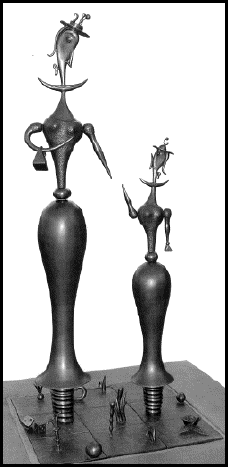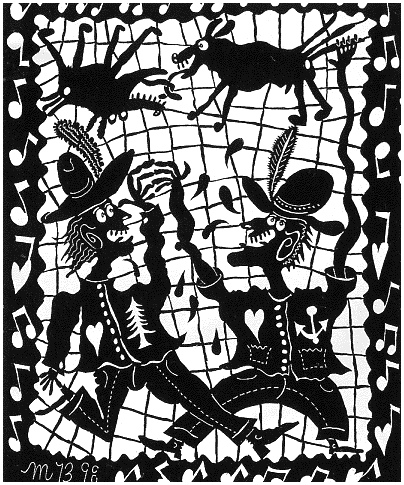Jesters:
Innovators of
Visual Wit
And Humor
Nicholas Roukes
(Ten Speed Press)

- One of the masters of the form is the great Giuseppe Arcimboldo (1540-1589) whose singular, and unfortunate, accomplishment was to fuse the still life with human portrait painting. A forerunner of minimalism, his portraits made no pretension to grandeur, metaphysical statement, symbolism, sex, or drama, but rather gives the viewer something else --- especially if he missed dinner.
Artful Jesters includes Pieter Bruegel, although calling some of the awfuls that go on in his paintings a "jest" might be an understatement. Alexander Calder is here with a circus, Merit Oppenheim has a fur-lined tea cup and spoon, Miro and Klee, but no Dali or Duchamp --- the latter mentioned but the famous urinal not shown.
George Herriman's Krazy Kat is cited as "comic surrealism," whatever that might be, as is one we've never run across before: Remedios Varo, who painted "mechanical devices, eccentric vehicles, strange scientific apparatuses, and solar system models in odd combinations and hybrid forms."
 Others from what we might think of as the middle period of Dadism include René Magritte, Philip Guston, and one H. C. Westermann who specialized in ominous chrome sculpture. Robert Arneson contributes glazed ceramic binoculars with a pair of weary eyes peering out rather than in. There is a plaster "Head of a Warrior" by Picasso, and an example of "Art Brut" by Jean Dubuffet ("Art is a compound of intoxication and madness," he said.)
Others from what we might think of as the middle period of Dadism include René Magritte, Philip Guston, and one H. C. Westermann who specialized in ominous chrome sculpture. Robert Arneson contributes glazed ceramic binoculars with a pair of weary eyes peering out rather than in. There is a plaster "Head of a Warrior" by Picasso, and an example of "Art Brut" by Jean Dubuffet ("Art is a compound of intoxication and madness," he said.)
It's a mostly merry, mostly ridiculous collection. Certainly, one is tempted, at worse, to journey to Ferndale, California where the aforementioned boats appear on the waters in something called the "Kinetic Sculpture Race," where you can find the eponymously named Duane Flatmo racing "Crawdudes," "the Sub-Humans," "Tide Fools," "Torture," and, oh no --- "The King and Eye," complete with crown and giant roving eyeball.